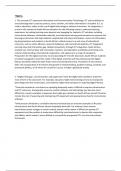*PART 1:
1. The acronym ICT represents Information and Communication Technology. ICT can be defined as
any technology that is used to produce, store, transfer, and utilize information is included. ICT, as
used in education, refers to the use of digital technology to enhance instruction. Its integration is
crucial in the context of South African education for the following reasons: enhanced learning
experience: by making learning more dynamic and engaging for students, ICT solutions including
instructional software, multimedia materials, and interactive learning environments can improve the
learning environment and help students comprehend and retain information. Access to Information:
by giving teachers and students in South Africa's schools access to a vast array of educational
resources, such as online libraries, research databases, and instructional websites, ICT integration
can help close the information gap. Global Connectivity: through ICT integration, South African
students can communicate with classmates, teachers, and specialists worldwide, promoting cross-
cultural understanding, international cooperation, and exposure to a range of viewpoints.
Preparation for the digital economy: by incorporating ICT into the classroom, South African students
are better equipped to meet the needs of the digital economy and they will possess the digital
literacy and skills needed for both future work and entrepreneurship. Promotion of 21st century
skills: the incorporation of ICT fosters the growth of critical thinking, problem-solving, creativity, and
teamwork abilities, all of which are crucial for success in today's globalized society.
2. *Digital skills gap: a lot of teachers and pupils don't have the digital skills needed to make the
most of ICTs in the classroom. For example, educators might need training on how to incorporate
technology into their lesson plans, and students might need assistance in acquiring digital literacy.
*Financial constraints: restrictions on spending frequently make it difficult to acquire infrastructure
and ICT resources. Giving pupils access to modern software and technology may become more
difficult as a result, examples of expenses that might put a burden on South African schools' finances
include the cost of acquiring and maintaining ICT equipment and paying license fees for instructional
software.
*Infrastructure limitations: unreliable internet and electricity are only two examples of the poor
infrastructure that South African schools frequently deal with. For instance, there may be
intermittent power outages in certain remote schools, which makes it difficult to operate ICT
equipment and the problem is made more difficult by restricted access to devices like computers
and tablets, which makes it more difficult to successfully incorporate ICTs into the instructional
framework.
, 3. The difference between students who have access to ICT resources and those who do not is
known as the "digital divide" in South African schools. This disparity affects how well pupils learn as
well as their capacity to pick up digital skills that are necessary in today's environment.
The effects on the availability of ICT resources and educational opportunities for students are:
limited access; South African students' inability to participate in digital learning and research is
hampered by their lack of access to computers, the internet, and other digital devices. Inequality: as
students from underprivileged homes are less likely to have access to ICT resources, the digital
divide makes already existing inequities worse by placing them at a disadvantage in comparison to
their more fortunate peers. Reduced learning opportunities: pupils lacking access to ICT resources
lose out on interactive and multimedia learning experiences, which restricts their exposure to a
variety of learning tools and impedes the development of their digital literacy.
Possible solutions to bridge this divide are: government initiatives; the government can carry out
plans to equip underprivileged schools with ICT resources, such as computers, internet access, and
digital teaching materials. Public-Private Partnerships: together, the public and private sectors and
nonprofit organizations can promote digital literacy initiatives, train teachers, and supply schools
with ICT resources. Community Centers: setting up community centers with ICT capabilities can
assist close the access gap for pupils who don't have it at home by giving them access to digital
materials after school. Mobile Learning: by utilizing mobile technology for instructional purposes,
students in rural areas, where traditional ICT infrastructure may be lacking can be reached.




